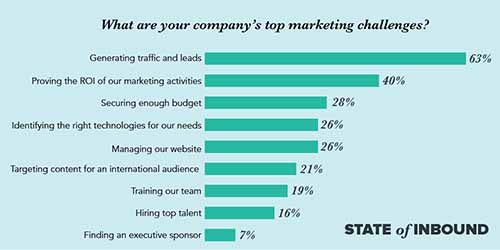As we’re starting a new year, a question may be lurking in your mind.
“What marketing channels should I use to grow my business this year?”
It’s a good question. Select the wrong marketing channels, and you’ll spend a lot of money on wasted efforts. Choose wisely and reap the rewards.
Because the marketing process is different for every single business, there isn’t a cut and dry answer.
John Wanamaker had it right when he said: “Half the money I spend on advertising is wasted; the trouble is I don’t know which half.”
Yet choosing is critical. If you’re expanding into a new market, selecting the wrong channel can have massive consequences. You’d be putting the rest of your business at risk for a marketing channel that may not pan out.
Still, as a marketer, you have certain goals in mind. You have certain priorities in place.
According to statistics, those needs can range from converting leads into customers to reducing the cost of acquisition.

But wherever your priorities fall, one thing is for sure:
It’s impossible to ignore the online world and all it can bring to the table.
- One-third of the world is on social media
- 74 percent say they use Facebook for professional purposes
- Content consumption on Facebook alone has increased 57 percent in the past two years
Yet even through all of this, 60 percent of business owners still say they are not able to track ROI from their social media activities.
That makes selecting an online marketing channel even a bit scarier.
What’s a business owner to do?
The one piece of advice we offer to all of our clients is:
Resist the urge to diversify
We talk with people that jump online and try a little bit of everything, just because “a friend” told them it was the “latest and greatest.” Trouble is, it may not be the best thing for you.
What can you do with new profile pages on Twitter, Facebook, Instagram, Pinterest, and YouTube when you don’t have any content to fill them with? How are you supposed to make Google recognize you when you don’t have a strategy in place?
Diversifying may be good in the long term. But in the beginning, focus is your best friend.
You’ll have more impact. When you control one marketing channel at a time, you leave a good impression with every message you put out to the world.
You’ll learn where your strengths lie. You can test different messages to determine what your audience likes best.
You’ll control the space rather than leaving it to your competition. You’ll have a clearcut message in mind.
You’ll spend less. The more you learn, the more you’ll know where your money is best spent.
Select a marketing channel. Put your energy there until it succeeds. Then use your knowledge and your successes to move into other areas.
Make sense?
Then let’s begin.
Dig Deeper
Worried About Click Fraud With Your Google Ads?
Think Like Google To Reap The Rewards With Site Rank
Step #1: Know Your Options
Let’s face it; it’s easy to get overwhelmed. Especially when you read about major successes in marketing channels you know little or nothing about.
Sure, you’ve heard about Facebook and Twitter. But how do you work them?
Then there are concepts you might not be familiar with. SEO. Display ads. Retargeting. SEM. Blogging. Adwords. PPC. SEO Content marketing.
As you start piecing together a strategy, you’ll likely find your channels start crossing over and blending together. That’s natural. The online world is a very fluid place.
Go where your customers lead you. When you dive into Facebook, you may discover that utilizing content and building up your blog makes perfect sense.
And that’s okay. Go where your audience is and give them what they desire.
Step #2: Choose Channels That Align With Your Business
Some businesses are made for certain channels.
An interior designer can do very well on Pinterest. It’s made for photographs.
A business coach can do very well on Youtube. Video coaching can increase exposure exponentially.
Some marketing channels are simply better suited for accomplishing certain things. And it becomes pretty obvious which direction you should go when you think about the direction you’re leading your business.
What are you hoping to accomplish? There are only three ways of bringing in sales to your business:
- Bringing in new leads
- Increasing the amount each customer spends
- Increasing the number of times each customer buys from you
And depending on where you are with your business goals, the way you market will change accordingly.
Lead generation is different than brand awareness. Growing your list is different than maintaining a happy customer base.
And how you do that ultimately impacts the effort you put into your marketing channel.
Step #3: Prioritize
This is your easiest step. If you’ve done your homework right up until now, you understand how your marketing channel can reach out to your target audience. Now all that’s left is finding the right one.
This is when it’s important to build the structure before you throw money into it. If you don’t have all the pieces in play, you’ll be missing crucial components.
For example, SEO is a great place to start. In short order, you can direct as much traffic as you desire to specific pages. But if those pages don’t have much to say, you’re traffic will go away.
A page on Facebook is great. A PPC ad on Facebook can let your target audience know about a new product or service. But if your click takes them to your home page, with no mention of said product or service, you’ve lost the potential forever.
That’s where we can help. That’s where we can help you map out your strategy, make wise choices, and put together the structure you need to reach your target audience through the different marketing channels online.
You might not understand their full potential, but we do.
It takes time and commitment to focus and make it work. It takes testing and doubling down on what works best.
What’s the best marketing channel for you?




